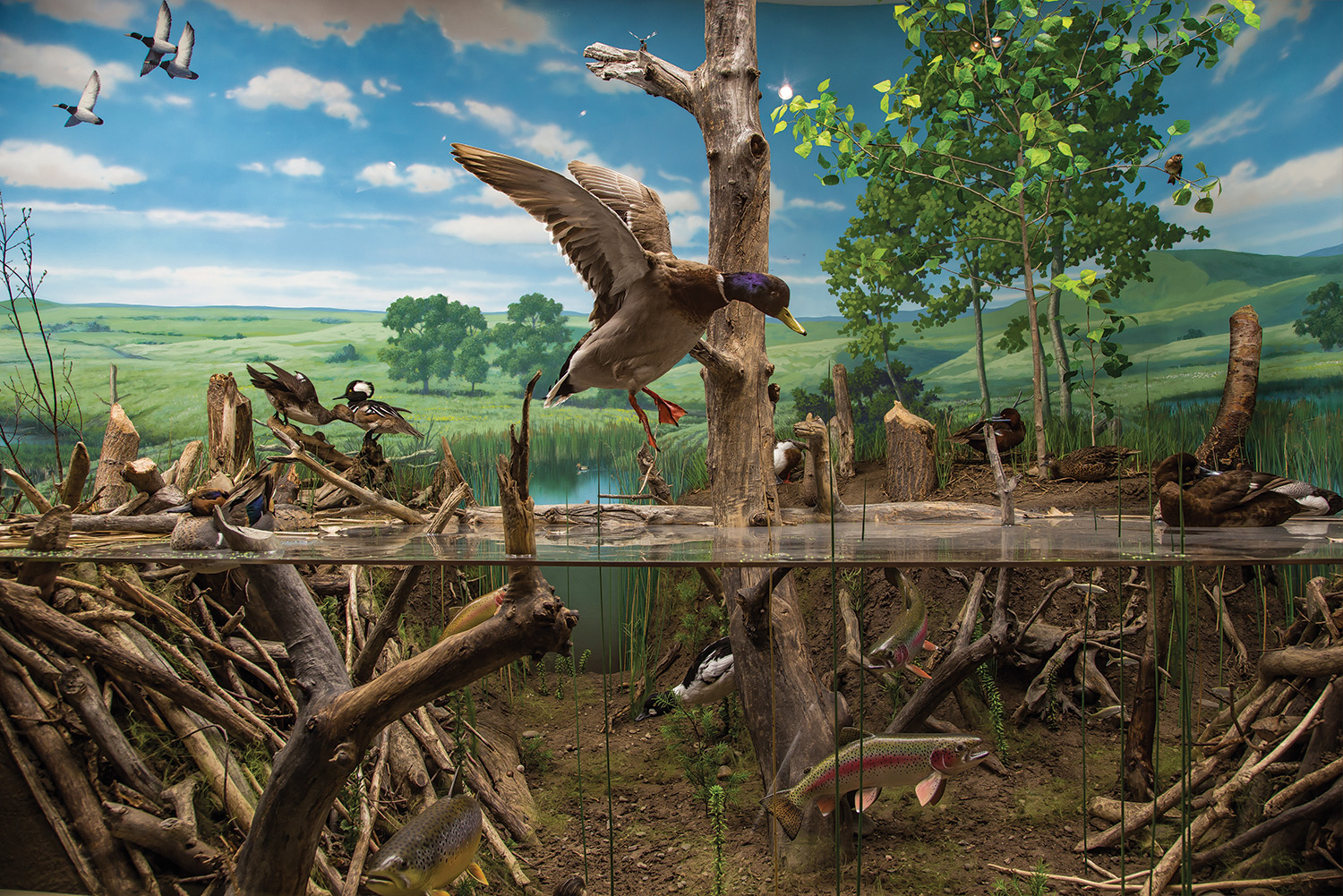
30 Nov The Wildlife Museum
I was 14 or 15 years old when my father, Burl Jones, created a wildlife museum. This was a couple of miles south of Livingston, Montana, off Highway 89. Dad was on his way to an applauded career as a bronze artist, and had just finished building an art gallery. Next to the gallery, additional space was being leased out to a sporting goods store and a gift shop. We called the whole thing “the complex.” Think false storefronts and wooden boardwalks. Hitching posts. An endless flow of Yellowstone Park traffic scrolling past just 50 yards away. A few tourists stopped, and we conspired always for ways to grab more of them.
Dad had been trained as a dentist, but was self-taught as a sculptor and taxidermist. An avid hunter, he already had a good collection of his own trophies: bighorn sheep, Dall sheep, a couple mountain goats, elk. A Yukon moose that had briefly been a world record. A taxidermist friend suggested that maybe a wildlife museum would help bring ‘em in. Dad could use his own collection as a starting point and build out from there.
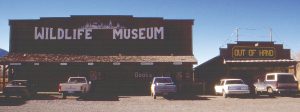
The Livingston, Montana, wildlife museum, built by the author’s father, contained some mounts that were repurposed in the Blaine County Wildlife Museum in Chinook, Montana.
The idea struck a chord, and Dad started cruising Montana Fish, Wildlife & Parks game auctions, looking for deals. He talked to professional taxidermists about hides and horns for sale. Life-sized, manila-colored taxidermy forms began arriving in crates.
Dad had dioramas in mind, à la Carl Akeley and the American Museum of Natural History. Painted backgrounds and animals arrested at the moment they ran; they alerted, they bugled. Dad would paint the backdrops himself. For the cliffs and dirt and creek beds, he bought a high-density, spray-foam insulator. I remember a metal wand with a trigger and an air compressor. Dad’s work clothes — all of our work clothes — came to be speckled with dried dots of yellow foam. He built armatures out of two-by-fours and chicken wire, coated them with foam, let the foam dry, cut it away into the shapes of rocks, riverbeds, sand dunes, then painted everything accordingly. On our family hiking or fishing trips, we might pull off to scavenge some branches or grass or cedar logs from the barrow pit. “This’ll look good in the grizzly exhibit.”
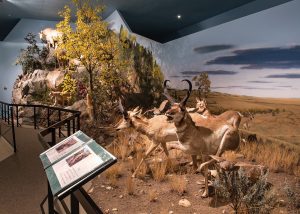
The Blaine County Wildlife Museum went to extraordinary effort and expense to create a series of realistic displays, including “Peaks to Plains.”
It was during these months that I really learned, through repetition, to flesh a hide, clean a skull, build up the orbits around an eye with papier mâchè. I held flaps of wet, tanned leather together while Dad stitched them up with twine. The whole family pitched in, but the bulk of the work was Dad’s. Most of the forms he ordered needed to be modified to suit his vision. He cut off legs and repositioned them; created joints, drilled holes, inserted dowels; turned heads and opened mouths.
The installation was finally housed in a two-story metal building down the boardwalk from the gallery. Museum attendant became my part-time summer job. Opening at 7:45 in the morning, if you’re 15 or 16 years old, feels briefly like a privilege — having the place to yourself. I flicked on a bank of lights in the front room, illuminating the cash register and books, curios, spinner racks, a glass case of turquoise jewelry. I walked through into the museum proper and turned on another set of lights. Most mornings, I took a quick tour, picking up any trash that might have been missed from the day before. Past the two bull moose fighting head-to-head in alders, the grizzly bear on its hind legs off a kill, a scrap of fur in its mouth, slivers of polyurethane meant to be saliva. One bull elk bugled across the aisle to another. Then there was the buffalo jump. Three bison falling off a cliff, through the floor, and into the basement, one of the bison arrested halfway down, pinned to the cliff by a metal pipe along its ribs, telescoping into a slightly larger pipe embedded in the wall. There were interpretive signs along the way.
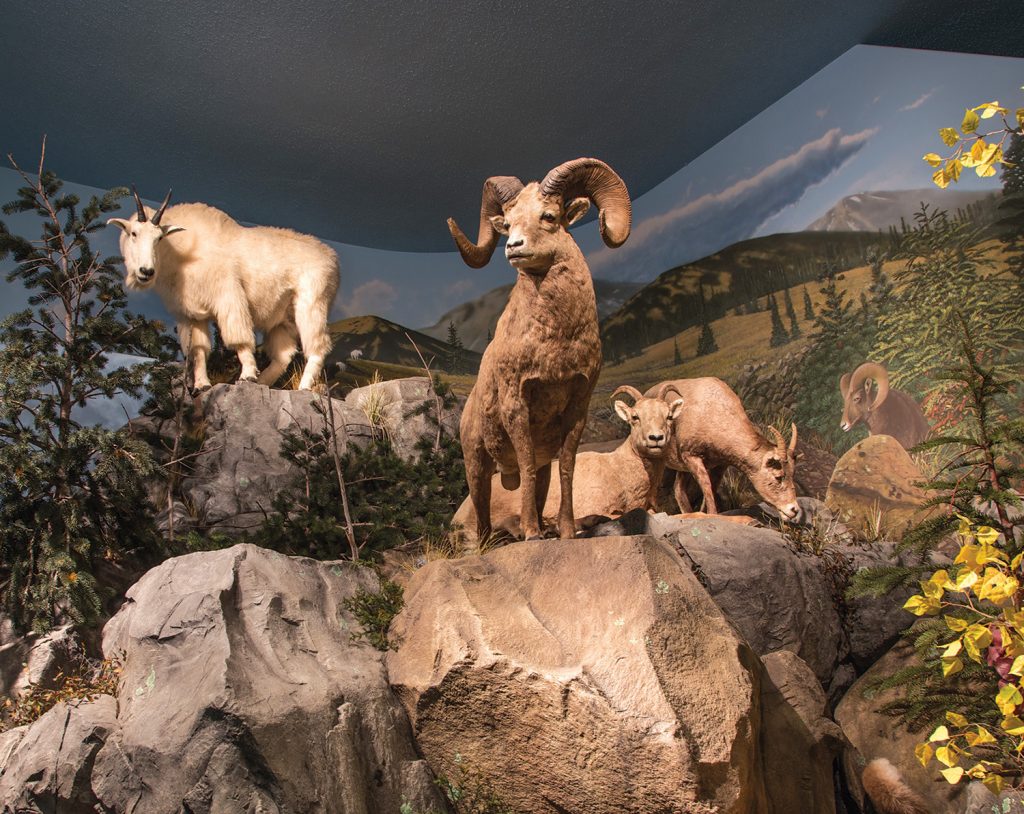 Bighorn sheep and mountain goats are part of the Blaine County Wildlife Museum’s “Peaks to Plains” exhibit.
Bighorn sheep and mountain goats are part of the Blaine County Wildlife Museum’s “Peaks to Plains” exhibit.
I thought it was art, and like all art, there was some risk involved. You don’t want to bring something momentous into the world only to see it shrivel up small. You don’t want to bleed out onto the page, the canvas, the museum, only to later find that your sacrifice was for naught.
Mom and Dad sold the museum not long after I left for college. Within a year or two, the new owner (his heart clearly not in it) closed the business entirely. He sold the building and auctioned off the contents. Over the course of a single day, all of Dad’s work, his own trophies as well his one-of-a-kind taxidermy sculptures, dispersed into the ether. If it bothered him, he didn’t let it show. It may have bothered me more — in the way of a college kid coming home to find that Mom has turned his old bedroom into a sewing station. Here was a piece of my own story that wouldn’t be coming around again. Mom and Dad were out of town when the auction happened, and we never knew what became of most of the animals — although the subject did occasionally arise: “I wonder where that white elk ended up?” For 20 years and more, we didn’t know.
Until two years ago.
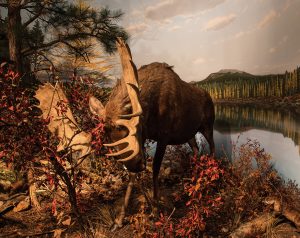
The museum’s “Moose Grizzly Encounter” used a moose that was originally created for the Livingston museum.
In 2015 I worked as publisher and editor on a book called Fifty-Six Counties: A Montana Journey. The author, Russell Rowland, traveled to each of the counties within the state, sketched out the history, and then updated that history with his own impressions. Eleven o’clock at night, I was going through my first editorial pass, and came across this passage:
The Blaine County Wildlife Museum in Chinook was one of the most pleasant surprises I encountered on my travels. The museum was first conceived in 1991 when a local group of business owners were able to acquire the local Blaine County Theater for a dollar from the Blaine Bank of Montana.
Dave Taylor is on the board of directors for the museum, and the story of how this museum went from an empty building to the really impressive facility it is today is another great example of how small communities in Montana are able to come together and accomplish amazing things when they’re determined enough.
Over the next 20 years, the museum board planned an annual fundraising dinner … and solicited private donations so that they were able to slowly act on a plan to create a unique place for people to come and see all the various forms of wildlife from Montana, in their natural settings. They were fortunate to be able to acquire many of the animals, which are stuffed, from a wildlife museum in Livingston that closed down just about the time they were getting started.
So. Huh. Well now.
I wrote Russell an email. “That was us!” I called Dad the next morning. “So I’m reading through this new Bangtail book …” And in August 2016, my wife and I took our five-year-old son on a road trip, Scobey to Glasgow, with Chinook in the middle. The Hi-Line. The Little Rockies to the south, Canada to the north, and trains running past in a constant stream — carrying wheat and coal, mostly. There’s wealth in Seattle, wealth in Chicago, but the middle keeps getting passed over. Most of the small towns that once served as support centers for the wheat farms are now being boarded up.
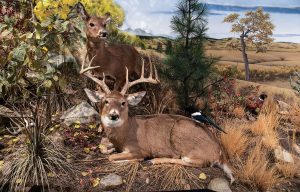
A whitetail buck and doe round out the Peaks to Plains exhibit.
Like other towns on the Hi-Line, Chinook has been having a hard time of it. When I met Bill Harbolt, also on the board of directors of the Blaine County Wildlife Museum, one of the first things he told me was that he had graduated from high school in Chinook in 1967. “Back then, there were five car dealers in town. Now there’s one. There were five lumber yards, now there’s zero. Eleven service stations, now there’s two. Four hardware stores, now there’s one. Three grocery stores. Now there’s one.”
It’s not much of a stretch to suppose that Harbolt and the other principals involved must have been worn out by the decline. And that, by god, they were going to do something about it. “Too many tourists come to Montana for the wildlife,” Harbolt said, “but then they never get to see it.” Harbolt and his cohorts saw an opportunity. A chance to prop up one corner of Chinook.
We stood in the gift shop at the front of the building. My son went to look at the stuffed toys. I found myself, oddly, a little nervous. I kept glancing past Harbolt toward the museum proper. I offered to pay admission, but Harbolt waved it away. “Come on in.”
Within the former movie theater, supported by an armature of community, sprayed on over a structure of determination and goodwill, I found a wildlife museum that, even while containing elements from my own history — was something almost entirely new. It was its own creature.
There were four major exhibits, laid out in a horseshoe pattern, each with detailed, hand-painted backdrops. The “Peaks to Plains” background alone apparently had taken more than a month to complete. It had Dad’s running antelope, and a whitetail buck bedded down in grass. A bighorn sheep I recognized, a rattlesnake curled up, ready to strike. When Dad and I later went through the photos together, he paused over a shot of the whitetail. “I found those antlers in West Virginia,” he said. “A farmer up Higgenbottom had them in his yard.” He smiled a little. “I think I offered him something like $10 for those.”
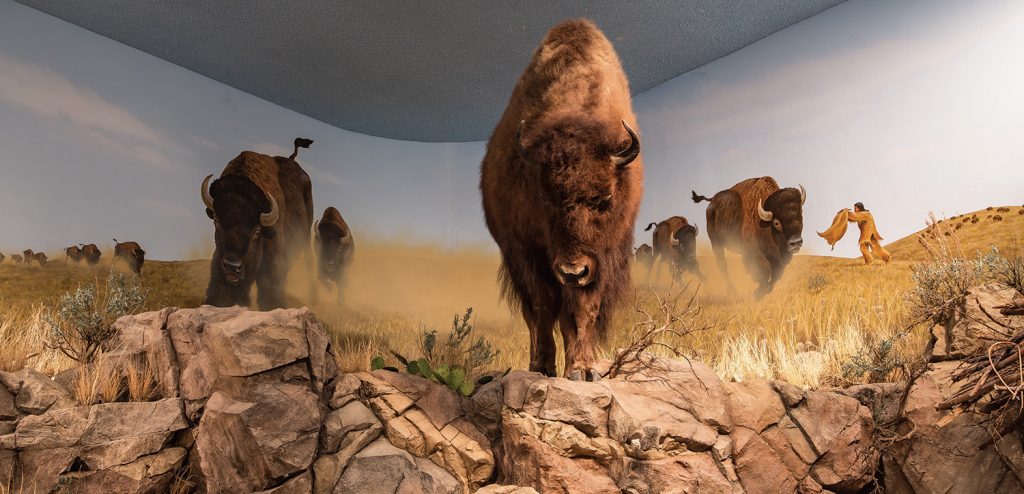 A buffalo jump exhibit includes motion-activated sound effects such that visitors can hear the thunder of hooves coming nearer and nearer.
A buffalo jump exhibit includes motion-activated sound effects such that visitors can hear the thunder of hooves coming nearer and nearer.
The “Moose Grizzly Encounter” had repurposed one of the moose from Dad’s exhibit. I remember how Dad had tilted that head forward, how he’d repositioned the legs. But the “Wetlands” exhibit, with its Canada geese, red-winged blackbirds, ducks, beavers, reeds, Lucite water, and trout (the lighting under the water had been darkened to account for refraction) was entirely new to me. “We’ve worked with five or six taxidermists around the state,” Harbolt said.
Then there was the buffalo jump. The three bison, cleaned up, repositioned. Placed on a larger cliff, at the mercy of mannequins wielding spears. Harbolt said, “We brought in animal bones to put around the base of the cliff. That buffalo skull there came out of the Milk River.”
We stepped closer. A motion-activated soundtrack kicked in. “Hear the birds chirping? Okay, now listen, there’s going to be a stampede of buffalo. Indians are going to start hollering now.” One of the bison was arrested halfway down, presumably by telescoping pipes along the ribs.
There were labels and interpretive folders, along with the names of supporters. The museum maintains an adopt-an-animal program wherein community members can chip in. “We’re a small town. People are really good about supporting us.”
While Harbolt walked us through the museum, another museum director, Scott MacKenzie, joined us. Between them, they described how they had found Dad’s work, and how it came to be in Chinook. “We were at an event in Bozeman,” MacKenzie said, “and we saw a flyer advertising a wildlife auction the next weekend in Livingston. Last minute, we ended up chartering a flight down.”
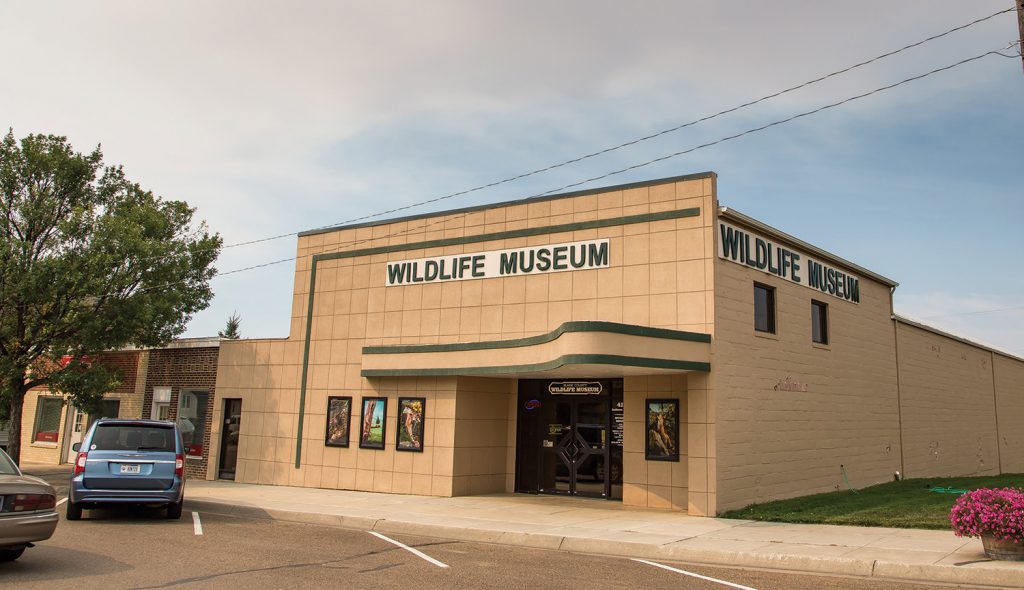 Housed in a former movie theater, the Blaine County Wildlife Museum is a tribute to what can happen when a community comes together for a shared purpose.
Housed in a former movie theater, the Blaine County Wildlife Museum is a tribute to what can happen when a community comes together for a shared purpose.
During the auction, the museum competed with the Rocky Mountain Elk Foundation and a private collector from Wyoming. And while they lost a few of the bigger pieces, they finally took away the largest portion of the collection, paying around $25,000 for their mounts. Afterward, they drove a large horse trailer to Livingston to pick them up. It took two trips Mackenzie added, “We didn’t know it all came from one guy.”
A good portion of the mounts they bought are still in storage. But they have plans for an expansion. “We’ve bought property next door,” MacKenzie said. A donor from New York has pledged a significant contribution, and monies are coming in from other sources as well. “Travel Montana has given us four grants. Blaine County pays our insurance, and we have a fundraising dinner every year. We’ve had 23 or 24 dinners now. And last year we grossed $47,000.”
Walking through the exhibits, Mackenzie and Harbolt talked over some housekeeping matters. “We need to get a ladder in here. Replace some of those bulbs.” But I was struck by the obvious pride they maintained in their project. At an exhibit featuring a black wolf in nighttime, MacKenzie said, “Notice how the snow sparkles? That was a decision. How much sparkle should we put in the snow.” He mentioned the subtle blue lighting. “They just got it perfect, you know?”
The environments were done by Kurt Wohnsen and Elizabeth Marshall of Acorn Exhibits out of St. Paul, Minnesota. “We created the habitats,” Wohnsen told me over the phone. “We tried to take the taxidermy that was supplied to us and tell a story with it.” Their first trip to Chinook was in 1999. From there, they’ve built the museum in pieces, as funds became available. Starting with the buffalo jump before moving on to the Wetlands exhibit then the Peaks to Plains exhibit, they’ve gradually built a complementary cycle of narratives, available one after the other. On their most recent trip to Chinook, among other work, they created two portable exhibits that demonstrate the process of taxidermy. “A lot of people come in, especially children, and don’t understand what’s inside the animals. So these exhibits show the various things that are used in the process, the glass eyes and artificial noses, that sort of thing.”
The thing about art … it never exists in a vacuum. Never. Each new piece occurs within a larger context. It reinterprets or reinvents, it pays tribute to or reacts against the work of its predecessors. Driving away from Chinook, heading toward Glasgow, I was a little maudlin. At one point, my wife asked, “So, what did you think?”
I considered my own reactions. Pride in my father’s work, gratitude that it was being repurposed. Melancholy at time gone by. Finally, maybe a little jealousy, seeing how a community could come together for such a shared, creative purpose. “That was … yeah. Man, that was something else.”




Polly Robbins
Posted at 14:30h, 02 MayYesterday I was talking with a work friend about my delight of the gem museums that I’ve encountered off the beaten path of the West and Northwest….. The Mary Hill Museum, The Bainbridge Art Museum, The High Desert Museum, the Neon Museum and the Charlie Russell Museum, and of course, the Blain County Wildlife Museum are ones discovered so far.
I passed trough Chinook on the way back from a friends family reunion a few years ago, and was surprised astounded by the installations at the Wildlife Museum. I was impressed by the amount of thought that went into all aspects of the exhibit design. (I have a bit of a describing eye for this kind of thing, because of my own work in creating environments for stop motion animation, including the movies of Guillermo del Toro’s Pinocchio, ParaNorman and The Boxtrolls.)
I just wanted to chime in and say that the effort of funding and developing the Blaine County Wildlife Museum is greatly appreciated. Thank you.
(If you have discovered your own gem museums off the beaten path, I’d love to hear about them.)
Ray Gossack
Posted at 03:59h, 07 FebruaryMy name is Ray Gossack, and I was with my dad Bob Gossack when he shot the “White Elk” in 1981 west of Anaconda. My dad sold the elk to his friend Dan Quillen to be mounted and displayed at the Wildlife Museum south of Livingston. We were disappointed to hear the business sold and all the mounts were actioned off never to be seen again. It would sure be nice to know where that white elk ended up. My dads desire was for it was to stay in Montana and to be able to be viewed by the public. Obviously that has not happened, but it would still be nice track it down. If you have clue to its whereabouts, please let me know. Thanks!